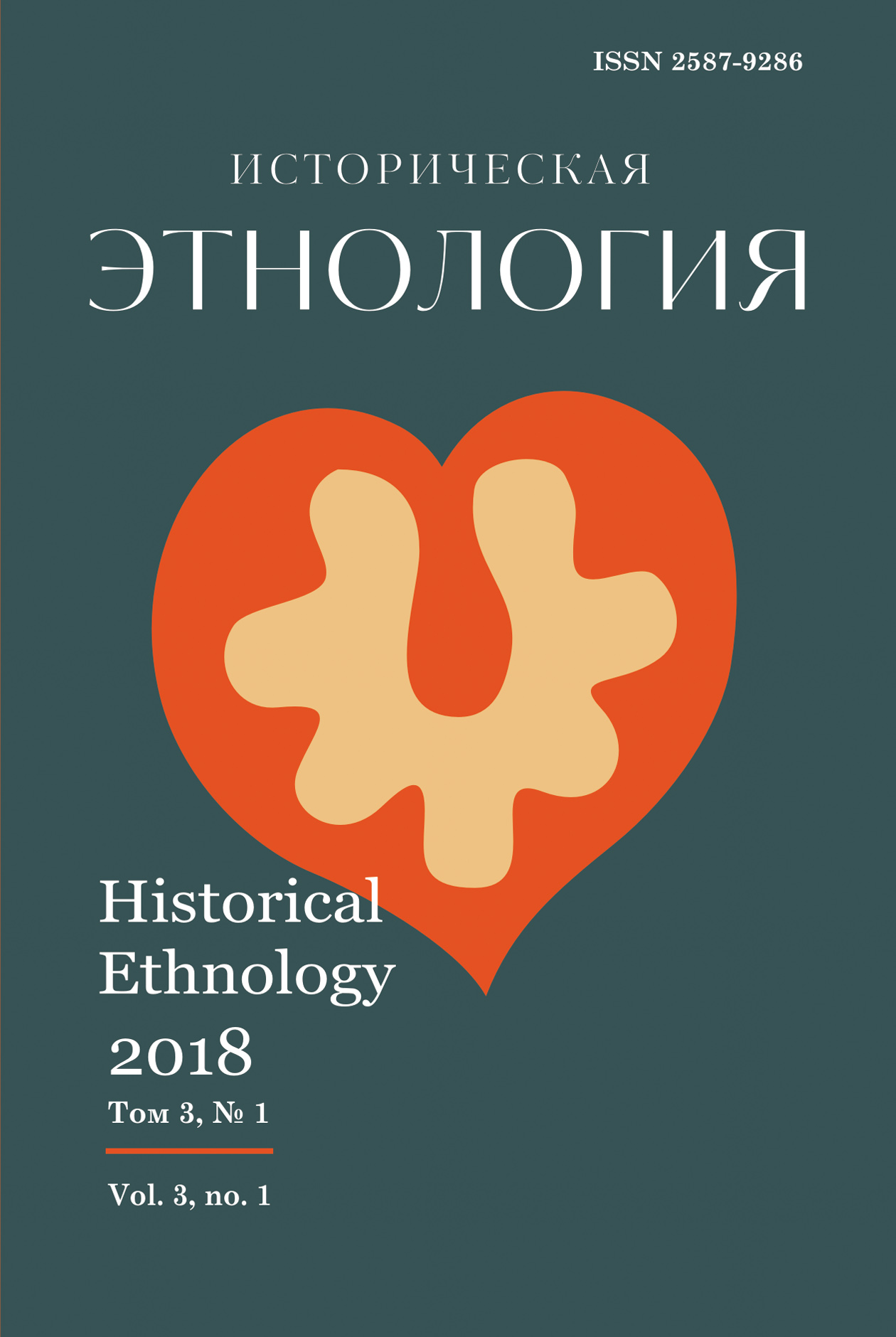Tatar Jewelry Art: Question of TatarRussian Syncretism in Handicraft Traditions of Kazan Volga Region
L.N. Donina, S.V. Suslova
69-80 p.
doi.org: 10.22378/he.2018-3-1.69-80
The article is devoted to the identification and archaeological and ethnographic interpretation of technical and technological features of the Tatar jewelry art. Kazan was one of the largest jewelry centers in the Russian Empire, distinguished by the peculiarities of technical and technological and ornamental techniques of jewelry, formal and morphological content of jewelry. Tatar jewelers had a grip on almost all technological processes, but they acquired a special skill in the art of filigree and embossing. In historiography there was a belief that the so-called knobby filigree is “distinctive and unique appliances that have not received distribution in jewelry of other Nations” (Tatar encyclopedia, p. 468). However, recent research (RFFI, project № 13-06–97056) showed that it was common in the jewelry of some of the peoples of the European part of Eurasia since the 11th century. Analogues of Kazan Tatar lumpy filigree of the 18th – the first half of the 19th centuries were revealed for the first time in Russian (religious) and European (secular) traditions of jewelry art. Original kind Tatar coinage is the coinage identified by the researchers (F.H. Valeev) as a high-relief. On the products, which were made using this technique, presence (merger) of regional traditions characteristic of Tatar and Russian art have been revealed. Manifestations of syncretism, whoch are observed in a number of technologies of Tatar jewelry production, are probably due to the existence of numerous Russian jewelry centers in Kazan, the Kazan Volga region as a whole (usually in monasteries), including a large handicraft in the village of Rybnaya Sloboda.
Keywords: filigree, Tatar, Russian jewelers, embossing, jewelry technology
For citation: Donina L.N., Suslova S.V. Tatar Jewelry Art: Question of TatarRussian Syncretism in Handicraft Traditions of Kazan Volga Region. Istoricheskaya etnologiya – Historical Ethnology, 2018, vol. 3, no. 1, pp. 69–80. DOI: 10.22378/he.2018-3-1.69-80
REFERENCES
1. Avizhanskaya S.A., Bikbulatova N.V., Kuzeev R.G. Dekorativno-prikladnoe iskusstvo Bashkir [Decorative and Applied Arts of Bashkirs]. Ufa, Poligrafkombinat Publ., 1964. 260 p. (In Russian)
2. Valeev F.H. Narodnoe dekorativnoe iskusstvo Tatarstana [Folk Decorative Art of Tatarstan]. Kazan, Tatar Book Publ. House, 1984. 188 p. (In Russian)
3. Vorobyov N.I. Kazanskie tataryi. Etnograficheskoe issledovanie materialnoy kulturyi dooktyabrskogo perioda [Kazan Tatar. Ethnographic Study of Material Culture of the pre-October Period]. Kazan, Tatgosizdat. Publ., 1953. 383 p. (In Russian)
4. Goldberg T., Mishukov F., Platonova N., Postnikova-Loseva M. Russkoe zolotoe i serebryanoe delo XV–XX vv. [Russian Gold and Silver Business of the 15th –20th Centuries]. Moscow, Nauka Publ., 1967. 342 p. (In Russian)
5. Davyidova S.A. Proizvodstvo metallicheskih izdeliy v Ryibnoy Slobode Laishevskogo uezda Kazanskoy gubernii [Production of Metal Products in the Fish Settlement of Laishevsky District of the Kazan Province]. Otchetyi i issledovaniya po kustarnoy promyishlennosti v Rossii [Reports and Research on the Cottage Industry in Russia]. Vol. 3. St. Peterburg, V.Kirshbaum Printshop, 1895. 117 p. (In Russian)
6. Klyuchevskaya E.P. Slovar kazanskih hudozhnikov. Vtoraya polovina XVI – nachalo XX veka [Dictionary of Kazan Artists. The Second half of the 16th – early 20th Centuries]. St. Peterburg, Slaviya Publ., 2009. 120 p. (In Russian)
7. Kostomarov N.I. Ocherk domashney zhizni i nravov velikorusskogo naroda v ХVI–ХVII stoletiyah [Essay on Home Life and Customs of the Great Russian People in the 16th – 17th Centuries]. St. Peterburg, K.Vulf Prinshop, 1860. 214 p. (In Russian)
8. Kramarovskiy M.G. K istokam kazanskoy skani [To the Origins of the Kazan Scan]. Srednevekovaya Kazan: vozniknovenie i razvitie. Materialyi Mezhdunarodnoy nauchnoy konferentsii. Kazan, 1–3 iyulya 1999 goda [Medieval Kazan: Origin and Development. Materials of the International Scientific Conference. Kazan, July1–3, 1999]. Ed. by F.Sh. Huzin. Kazan, Master-Layn Publ., 2000, pp. 272–278. (In Russian)
9. Kramarovskiy M.G. Vostok i Zapad v istorii i kulture Zolotoy Ordyi (po materialam chingisidskoy torevtiki XIII–XV vv.) [East and West in the History and Culture of the Golden Horde (according to materials kingisepsky toreutics of the 13th – 15th Centuries.) Dr. hist. sci. diss.] St. Peterburg, 2002. 61 p. (In Russian)
10. Lebedeva N.I., Maslova G.S. Russkaya krestyanskaya odezhda XIX – nachala XX v. [Russian Peasant Clothing of the 19th – early 20th Centuries]. Russkie. Istorikoetnograficheskiy atlas. Zemledelie. Krestyanskoe zhilische. Krestyanskaya odezhda. (Seredina ХIХ – nachalo ХХ veka) [Russian. Historical and Ethnographic Atlas. Agriculture. Peasant Housing. Peasant Clothing. (Mid 19th – early 20th Centuries)]. Chief ed. S.P. Tolstov. Moscow, Nauka Publ., 1967, pp. 193–267. (In Russian)
11. Martyinova M.V. Oklad ikonyi «Bogomater Mlekopitatelnitsa» iz sobraniya muzeev Moskovskogo Kremlya [The frame of the icon “our lady mammal” from the collection of the Moscow Kremlin museums] Drevnerusskoe iskusstvo XIV–XV vv. [Old Russian Art of the 14th – 15th Centuries]. Ed. by O.I. Podobedova. Moscow, Nauka Publ., 1984, pp. 101–113. (In Russian)
12. Maslova G.S. Narodnaya odezhda russkih, ukraintsev i belorusov [National Clothes of Russians, Ukrainians and Belarusians]. Vostochnoslavyanskiy etnograficheskiy sbornik. Trudyi instituta etnografii. Novaya seriya [East Slavic Ethnographic Collection. Proceedings of the Institute of Ethnography. New Series]. Vol. 31. Moscow, 1956, pp. 543–757. (In Russian)
13. Muhamedova R.G. Tataryi-mishari. Istoriko-etnograficheskoe issledovanie. [Tatars-Mishars. Historical and Ethnographic Research]. Moscow, Nauka Publ., 1972. 247 p. (In Russian)
14. Natsionalnyy Arkhiv RT [The National Archive of RT]. Fond 359, op. 1, d. 520, l. 121. (In Russian)
15. Pokrovskiy I.M. Kazanskiy Arhiereyskiy dom, ego sredstva i shtatyi, preimuschestvenno do 1764 goda. Tserkovno-arheologicheskoe, istoricheskoe i ekonomicheskoe issledovanie. (K pamyat 350-letiya suschestvovaniya Kazanskoy eparhii 1555–1903 gg.) [Kazan Bishop’s house, its funds and staff, mainly until 1764. Church-Archaeological, Historical and Economic Research. (In memory of the 350th anniversary of the Kazan Diocese in 1555–1903)]. Kazan, Tsentralnaya Prinshop Publ. 1906. 482 p.; Gramotyi. pp. I–XXX; Prilozheniya. pp. 1–264; Ukazatel. pp. I–XVI. (In Russian)
16. Rabinovich M.G. Odezhda russkih XIII–XVII vv. [Russian Clothing of the 13th – 17th Centuries]. Drevnyaya odezhda narodov Vostochnoy Evropyi. Materialyi k istoriko-etnograficheskomu atlasu [Ancient Clothing of the Peoples of Eastern Europe. Materials to the Historical and Ethnographic Atlas]. Ed. by M.G. Rabinovich. Moscow, Nauka Publ., 1986, pp. 63–111. (In Russian)
17. Safina F.Sh. Tkachestvo tatar Povolzhya i Urala: Istoriko-etnograficheskiy atlas tatarskogo naroda. [Weaving of the Volga and Ural Tatars: Historical and Ethnographic Atlas of the Tatar People]. Kazan, Fen Publ., 1996. 208 p. (In Russian)
18. Sterligova I.A. Dragotsennyiy ubor drevnerusskih ikon XI–XIV vekov. Proishozhdenie, simvolika, hudozhestvennyiy obraz. [A Valuable Piece of Ancient Russian Icons of the 11th – 14th Centuries. Origin, Symbolism, Artistic Image]. Moscow, Progress-Traditsiya. Publ., 2000. 264 p. (In Russian)
19. Suslova S.V. O tyurko-tatarskih traditsiyah v narodnoy russkoy culture [On the Turko-Tatar Traditions in the Russian Folk Culture]. Etnokulturnyie vzaimodeystviya v Evrazii: prostranstvennyie i istoricheskie konfiguratsii [Ethno-Cultural Interactions in Eurasia: Spatial and Historical Configurations]. Barnaul, 2012, pp. 195– 213. (In Russian)
20. Tatarskaya entsiklopediya: V 5 t. [Tatar Encyclopedia: in 5 volumes]. Kazan, AN RT Tatar Encyclopedia Institute Publ., 2002. Vol. 1: A–V. 672 p. (In Russian)
21. Troitskiy V.I. Kazanskie i sviyazhskie serebryaniki XVII v. [Kazan and Sviyazhsk Silversmiths of the 17th Century]. Kazanskiy muzeynyiy vestnik [Kazan Museum Bulletin]. No. 5–6. Kazan, First State Printshop Publ., 1920, pp. 11–16. (In Russian)
22. Chavushyan D.M. Tehniko-tehnologicheskie i hudozhestvennyie osobennosti moskovskoy skani kontsa XVIII – nachala XX vv. [Technical, Technological and Artistic Features of the Moscow Scan of the late 18th – early 20th Centuries. Dr. hist. sci. diss.] Moscow. 2008. 137 p. (In Russian)
About the authors: Larisa N. Donina is a Candidate of Science (Art History), Senior Research Fellow, Department of Ethnological Research, Sh. Marjani Institute of History of the Tatarstan Academy of Sciences (7А, Baturin Str., Kazan, 420111, Russian Federation); lis.art@mail.ru
Svetlana V. Suslova is a Candidate of Science (History), Advanced Research Fellow, Department of Ethnological Research, Sh. Marjani Institute of History of the Tatarstan Academy of Sciences (7А, Baturin Str., Kazan, 420111, Russian Federation); sv_suslova@mail.ru
|
|








